FirearmsPolice officers, like any other professional or craftsman, want the best tools they or their company can afford. Like any tool, one size may not fit all craftsmen or situations so manufacturers and departments must adapt to hand size, adaptability to recoil, and availability. Some manufacturers, such as Smith and Wesson, adapt by changeable grip panels to fit smaller hands. Other aftermarket grips are available for other weapons to make them adaptable to the operator. To the police officer a firearm is a tool, one which may be used to dispatch a severely wounded or dangerous animal. Sometimes the firearm is used to stop a threat to the public, or protect the life of citizens or the officer. Many early departments and many small modern departments, allow or require officers to provide their own firearms within department guidelines. These firearms are not cheap and could cost nearly a month's pay. In 1942, as an example, a new .38 Special Colt revolver cost about $40.00. The City of Rockaway hired the first police Chief, Robert Dunlop for $75.00 a month in 1942. He was to furnish his own weapon and drove his own car on patrol. Many early lawmen carried pre-owned weapons and some found they could purchase a used rifle or shotgun as well as a handgun at a price below that of a new Colt or Smith and Wesson handgun. Today's police professionals are paid a wage compatible with other departments in the County, furnished an official vehicle, and are allowed to purchase an approved firearm or use department issued weapons. The departments issue all duty ammunition and other regulations specify carry and use of firearms. If you look at the old western movies, you may get the impression that every cowboy, sheriff and bad guy carried a Colt single action "peacemaker" low slung, quick draw holster. And of course, like many legends, there is a grain of truth in that perception. If they had access to a Colt or other hi-grade firearm, they used it. The holster was probably designed more to protect the valuable gun than for fast draw. According to many of the reports from the era, many preferred a rifle and distance to the proverbial "showdown at high noon." Many, such as Wyatt Earp, were made bigger than life by pundits selling the proverbial "dime novel" glorifying the lure of the West. Prior to the Civil War, nearly all the weapons used by the military or the police, were single shot weapons. Most were fairly large and heavy due in part to the technical limitations of the gunpowder and projectiles of the period. Thus at close range against multiple assailants or if they malfunctioned or missed, they became a club following the attempt. For this reason, many early lawmen, such as Marshal Joe Meek, reportedly favored a rifle or a double barrel shotgun. Distance was considered to be your friend and the rifle was considered more accurate than a handgun. Both, in the event of miss or malfunction, gave the user the time to reload or retreat. Modern police weapons reflect the evolution from clubs, swords and various firearms from the 1800's to present. Weapons pictured, unless otherwise noted, are selected from the Wortman collection. Muzzle Loading Single Shot Handguns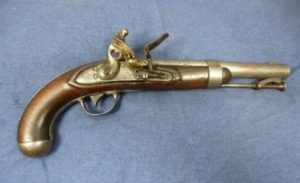 (photo T. Burness) 1836 Flintlock PistolSingle shot, flint or percussion. Often these weapons were current or surplus military arms. Sometimes, if the area policed was affluent, updated firearms might be supplied to the officers. This 1836 flintlock pistol by Robert Johnson is an example of the last pistol ordered by the US military. The user had one shot and then it was little more than a club. Muzzle Loading Revolvers (photo T. Burness) Colt 44 PercussionWhile revolving mechanisms were in use before 1835, most if not all, were manufactured one at a time by individual gun makers with very limited interchangeability of parts. Samuel Colt brought the industrial revolutions assembly line process to the manufacture of firearms in 1835 and began the process which would later lead to the mass production of revolving handguns. In the US, Colt pistols became the standard by which other arms were measured by the mid 1800's. This 1860 Army model revolver was a standard sidearm of the Union Army and was the platform used for the transition to cartridge as seen below. The Transition To CartridgeMuch advancement in firearms technology was made during the years leading up to or following the US Civil War. The development of the self-contained cartridge led to the development of the Henry repeating rifle (1860) and the Colt Single Action Army revolver (1873) the iconic "peacemaker" which, byway of some great advertising became known as the gun that "made men equal". Smith and Wesson marketed the first US cartridge handgun in 1857 with their model one. S&W patented the "through bored cylinder" to allow easy loading of cartridges as we know them today, forcing Colt and Remington to use a conversion system, cutting the cylinders of their revolvers and using a two part "conversion" cylinder to fire metallic cartridges. Smith and Wesson patents expired in 1869, allowing Colt and others to use the "through bored" cylinder, eliminating the need for the two piece conversion cylinder to hold the cartridge. The ammunition was "black powder" and these old guns are not safe to fire with modern smokeless powder. 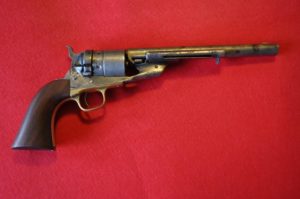 Colt 1860 Army revolver Colt 1860 Army revolver, conversion to .44 cartridge from "cap and ball" revolver used during the US civil war. This weapon originally made in 1864 was converted to cartridge, probably using the .44 Colt Center Fire ammunition. This revolver was later reconverted to the more readily available .44 Russian Center Fire cartridge. This weapon still has the 8" barrel considered necessary by the army for black powder efficiency. Many of these had the barrels shortened for more practical carry after the advent of cartridges and better powders. | 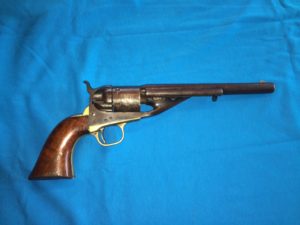 Colt 1861 Navy revolver Colt 1861 Navy revolver. This .36 caliber handgun was made in 1869 or 1870. It was originally built as a cartridge firearm in .38 (.357 diameter bullet) rim fire and appears to be a later conversion to .38 Colt center fire. The firing pin, attached to the hammer, appears to be a local "blacksmith" conversion from rim fire to center fire cartridge. 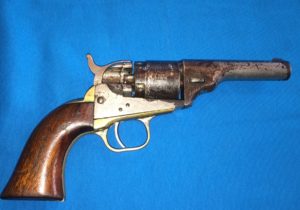 Colt 1872 Colt 1872, also known as the .36 caliber Pocket Navy. This pistol was made as a cartridge firearm at the Colt factory, using left over parts for the smaller Pocket Navy from the Civil War era. Manufacturers had a lot of spare parts left over when the war ended and Colt, Smith and Wesson, Remington and others all tried to use them to capitalize on the growing civilian market as the population pushed west in search of opportunity or gold. Single Action Cartridge Revolvers 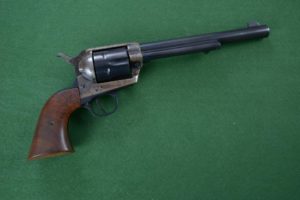 1873 Colt Single Action Model 1873 Developed by Colt after the Civil War, the model 1873 became the iconic cowboy firearm, some of the first generation were marked "Frontier Six Shooter" on the barrel. Known as the Single Action Army after the adoption by the U. S. Cavalry, it evolved further in the 1890's to meet the advent of the higher pressures developed by the new "smokeless" powders, the . They were and are, available in several calibers and barrel lengths, the weapons were effective and useful on the frontier. One drawback to these revolvers was that they had to be manually cocked for each shot and were slow to reload, although they were still faster than a single shot. Finishes included the bluing or in some cases nickel finish, to protect the weapon from both the elements and the residual acids found in the leather following the tanning process. This leather later used to make holsters and other weapon containers like rifle scabbards. Double Action RevolversColt and Smith and Wesson provided double action revolvers, these pistols will fire each time the trigger was pulled until all the Gun – Smith and Wesson ammunition in the cylinder is expended, generally 5 or 6 shots. 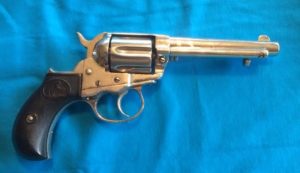 Smith and Wesson 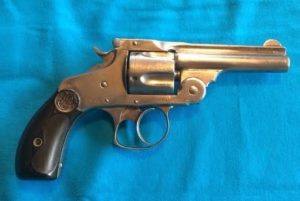 Colt 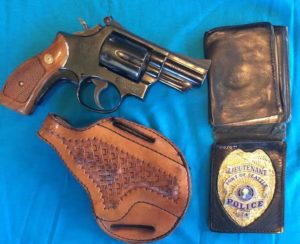 Smith and Wesson model 19 in .357 Colt used the same one at a time reloading system on their early double action revolvers while Smith and Wesson developed a break open system which allowed all of the empty cartridges to be removed quickly for reloading. Later development by both manufacturers involved a swing out cylinder and later advent of "speed loaders" to allow rapid reloading in cases of emergency. Advancements continued from the late 1800's through the mid- 20th century. Perfecting the mechanisms, the powders and the bullets led to highly effective handguns for police. Many of these weapons, such as the Smith and Wesson model 19 in .357, continue to serve today. This revolver was carried since the early 1980's by Ed Wortman, Chief of Police, ret. Washington State Patrol Colt Many large police departments, such as the Washington State Patrol, required officers to carry a department issued firearm. Some of the weapons are marked to identify them as department property. Displayed here are three weapons from the "patrol." Many departments requiring officers to carry a specific firearm, marked these firearms but later upgraded or traded the firearms to a dealer for improved models. The markings are not easily removed so they are generally left intact. Smith and Wesson model 28, .357 caliber, better known as the Highway Patrolman. Built by Smith and Wesson from 1954 to 1986 this .357 handgun was a staple of many police agencies. Manufactured with both 6" and 4" barrels, these heavy framed handguns were bulky but effective. Most of these weapons were replaced with semi-automatics in the early 1980's. This sample, manufactured in 1967, is marked as property of the Washington State Patrol Smith and Wesson model 17-2, .22 caliber, which matched the size and feel of the model 28. Used as an inexpensive training tool by those departments using the model 28 or other large framed revolvers to teach weapon handling and marksmanship. Smith and Wesson model 66-2, .357 caliber, issued to investigators. This stainless steel weapon is known as a K frame Smith and Wesson. This weapon marked as property of the Washington State Patrol. |

